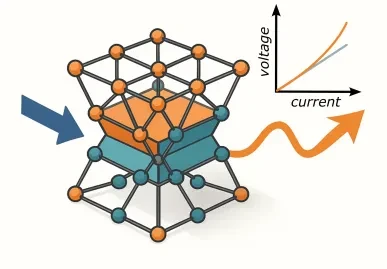Breaking Ohm’s Law: Nonlinear Currents Emerge in Symmetry-Broken Materials
The Nanodevices group at CIC nanoGUNE shows that breaking a material’s inversion symmetry can shatter Ohm’s law, unleashing powerful nonlinear phenomena. Their review, just published in Nature Materials, maps this emerging landscape and points toward a new generation of nano- and quantum-electronic devices.

In a review just published in Nature Materials, Manuel Suárez-Rodríguez—working under the guidance of Ikerbasque Professors Fèlix Casanova and Luis E. Hueso at CIC nanoGUNE, together with Prof. Marco Gobbi at the Materials Physics Center (CFM, CSIC-UPV/EHU)—takes aim at the oldest principle in electronics: Ohm’s law. Their article, “Nonlinear transport in non-centrosymmetric systems”, brings together rapidly growing evidence that, when a material lacks inversion symmetry, the familiar linear relation between current and voltage can break down, giving rise to striking quadratic responses.
“Over the past five years we have observed numerous reports of nonlinear transport effects intimately linked to the symmetry of the host material,” explains lead author Suárez-Rodríguez. “Once we grasped this connection, our goal was to weave the disparate results into a coherent picture that condensed-matter and materials physicists can exploit to advance this promising field.”
Co-authors Fernando de Juan (Donostia International Physics Center, DIPC) and Ivo Souza (CFM) helped clarify how broken inversion symmetry unlocks new microscopic mechanisms—chief among them the Berry-curvature dipole and the recently proposed Berry-connection polarizability—that generate nonlinear and rectification voltages directly from an applied bias. “Because these mechanisms are intrinsic to the material itself—not to interfaces or external stimuli—they can operate across a wide frequency range and down to the single-layer limit,” adds Suárez-Rodríguez.
Beyond fundamental interest, the team highlights two application frontiers. First, nonlinear effects provide a versatile and powerful route to probe charge-to-spin conversion, helping identify candidate materials for next-generation spintronics. Second, these effects can be harnessed for wireless radio-frequency rectification, promising size reductions of several orders of magnitude relative to state-of-the-art devices and enabling rectification at, or even below, the microscale—opening possibilities for on-chip RF harvesters and biosensors.
With more than 450 accesses in just two days, the review is already serving as a roadmap for researchers developing quantum-enabled electronics—where “breaking the rules” of Ohm’s law is the key.
Manuel Suárez-Rodríguez, Fernando de Juan, Ivo Souza, Marco Gobbi, Fèlix Casanova & Luis E. Hueso
Nonlinear transport in non-centrosymmetric systems
Nature Materials (2025)
https://doi.org/10.1038/s41563-025-02261-3
